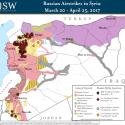 |
 |
Russia's Unrelenting Attacks on Syrian Civilians

Russia’s campaign against Syrian civilians continued undeterred by the U.S. strike on April 6 in response to the Bashar al-Assad regime’s use of chemical weapons in southern Idlib. Local reports indicate Russia regularly used incendiary munitions and bunker buster munitions in Idlib and Aleppo Provinces in order to inflict mass casualties on the population in rebel-held terrain following the U.S. strike. Russian airstrikes also targeted local civilian infrastructure from April 4 - 25, including hospitals, schools, mosques, and civil defense centers across Syria. Russia continually targeted Khan Shaykhoun, the site of the regime’s chemical attack on April 4, throughout the reporting period. Furthermore, activists claimed Russia targeted a hospital and civil defense center treating those wounded in Khan Shaykhoun immediately following the regime’s sarin gas attack. The use of chemical weapons is just one of many means the pro-regime coalition has to punish anti-Assad populations in Syria. Russia remains a principal contributor to President Assad’s purposeful campaign to target Syrian civilians. The Assad regime has a long history of violence against its own people, but the advanced capabilities Russia has brought to theater have allowed the pro-regime coalition to target civilians with even greater precision.
The U.S. strike on Shayrat did not meaningfully degrade the ability of the Assad-Russia-Iran coalition to attack anti-Assad forces and civilians throughout Syria. Russia provides the bulk of the pro-regime coalition’s asymmetric airpower against anti-Assad forces in Syria, while Iran provides high end manpower through the deployment of Islamic Revolutionary Guard Corps (IRGC), Hezbollah, and other Iranian proxy forces. Russia continued to provide the regime with necessary airpower to blunt opposition advances in Dera’a City in southern Syria, for example. However, Russia predominantly focused its airpower in northwestern Syria against the opposition and civilians from April 4 - 25, despite the pro-regime coalition’s continued counter-ISIS narrative. Russian airstrikes supported pro-regime advances in northern Hama and Idlib Provinces, enabling pro-regime forces to regain all territory lost to the opposition in the rebels’ most recent Hama offensive launched on March 21. Iran, Russia, and the regime have continued to push north amidst aggressive Russian airstrikes in the area, placing pro-regime forces within 13 miles of Khan Shaykhoun as of April 25. The regime’s rapid advance towards Idlib Province may increasingly force the remaining acceptable opposition to turn towards powerful Salafi-Jihadi partners for support. Russia’s continued operations in support of the Assad regime coupled with continued attacks against civilians in rebel-held areas will only further drive instability and radicalization within the Syrian conflict.
Low-Confidence Reporting. ISW places low confidence in reports corroborated only by multiple secondary sources, including from local Syrian activist networks deemed credible or Syrian state-run media.
By Genevieve Casagrande and Ellen Stockert